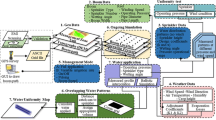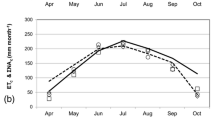Abstract
This paper presents a methodology for up-scaling field irrigation losses and quantifying relative losses at the irrigation area level for potential water savings. Two levels of analysis were considered: First, the field level where irrigation is applied. Second, the irrigation area level, where the field level losses are aggregated, or up-scaled, using average loss functions. In this up-scaling approach, detailed crop-soil-water modelling can capture the variability of physical parameters (such as soils, crops, water table depth, and management practices) at the field level which are then used to derive loss functions for aggregating losses at higher scales (irrigation area level). This allows potential field-level adaptations and water management changes made by individual farmers to be assessed for impact at the larger irrigation area level. The APSIM farming systems model was used for simulation of crops (wheat, rice, and soybean) and their interaction with the wider system processes at the field level. Given the climate, soil, and management information (sowing, fertilisation, irrigation, and residue management), the model simulates infiltration, the soil moisture profile, plant water uptake, soil evaporation, and deep drainage on a daily basis. Then, by placing the field level analysis in the context of the wider irrigation system or catchment, it is possible to correlate field level interventions (e.g. water savings measures) with water requirements at these higher levels. Application of this method in the Coleambally Irrigation Area in NSW, Australia, demonstrated that an exponential function can describe the relationship between deep drainage losses and the water table depth for different soil, crop, and water table depth combinations. The rate of loss increase (slope of the curve) with the water table depth is higher on lighter (higher intake rates) soils than on heavy soils and is more pronounced in areas under rice cultivation. We also demonstrate that this analysis technique can assist in identifying spatial distribution of losses in irrigation areas, considering water table depth as an additional factor, leading to targeted areas for water-saving measures.








Similar content being viewed by others
References
Asseng S, Keating BA, Fillery IRP, Gregory PJ, Bowden JW, Turner NC, Palta JA, Abrecht DG (1998a) Performance of the APSIM-wheat model in Western Australia. Field Crops Res 57:163–179
Asseng S, Fillery IRP, Anderson GC, Dolling PJ, Dunin FX, Keating BA (1998b) Use of the APSIM wheat model to predict yield, drainage, and NO3 leaching for a deep sand. Aust J Agric Res 49:363–378
Asseng S, Fillery IR, Dunin FX, Keating BA, Meinke H (2001) Potential deep drainage under wheat crops in a Meditteranean climate. 1. Temporal and spatial variability. Aust J Agric Res 52:45–56
Bastiaanssen W, Ahmad M, Tahir Z (2003) Upscaling water productivity in irrigated agriculture using remote-sensing and GIS technologies, in water productivity. In: Kijne JW, Barker R, Molden DJ (eds) Agriculture: limits and opportunities for improvement. Comprehensive Assessment of Water Management in Agriculture Series, No. 1. CABI Publishing, Wallingford, pp 289–300
Belder P, Bouman BAM, Spiertz JHJ (2007) Exploring options for water savings in lowland rice using a modelling approach. Agric Syst 92:91–114
Bethune M (2004) Toward effective control of deep drainage under border-check irrigated pasture in the Murray-Darling Basin: a review. Aust J Agric Res 55:485–494
Bouman BAM, Van Laar HH (2006) Description and evaluation of the rice growth model ORYZA2000 under nitrogen-limited conditions. Agric Syst 87:249–273
Cresswell HP, Paydar Z (1996) Water retention in Australian soil. I. Description and prediction using parametric functions. Aust J Soil Res 34:195–212
Dolling PJ, Latta RA, Ward PR, Robertson MJ, Asseng S (2005) Soil water extraction and biomass production by lucerne in the south west of Western Australia. Aust J Agric Res 56:384–404
Gaydon DS, Lisson SN, Xevi E, Dassanayake D (2006a) Value assessment of irrigation allocation forecasts for a rice-based operation in the Coleambally Irrigation District—in terms of water-use efficiency, production, and drainage. Final Report, CSIRO Water for a Healthy Country Flagship, Project No. T4.S2.P1, Murray Region Irrigation
Gaydon DS, Lisson SN, Xevi E (2006b) Application of APSIM ‘multi-paddock’ to estimate whole-of-farm water-use efficiency, system water balance and crop production for a rice-based operation in the Coleambally Irrigation District, NSW, Ground-breaking Stuff. In: Proceedings of the 13th Australian Society of Agronomy Conference, Perth, Western Australia, 10–14 September 2006
Grayson R, Blöschel G (eds) (2000) Spatial patterns in catchment hydrology: observation and modeling. Cambridge University Press, Cambridge, 403 pp
Humphreys E, Edraki M, Bethune M (2003) Deep drainage and crop water use for irrigated annual crops and pastures in Australia—a review of determinations in fields and lysimeters. CSIRO Land and Water Technical Report 14/03
Humphreys E, Lewin LG et al (2006) Integration of approaches to increasing water use efficiency in rice-based systems in southeast Australia. Field Crops Res 97:19–33
Jeffrey SJ, Carter JO, Moodie KB, Beswick AR (2001) Using spatial interpolation to construct a comprehensive archive of Australian climate data. Environ Model Softw 16:309–330
Keating BA, Carberry PS, Hammer GL, Probert ME, Robertson MJ, Holzworth D, Huth NI, Hargreaves JNG, Meinke H, Hochman Z, McLean G, Verburg K, Snow V, Dimes JP, Silburn M, Wang E, Brown S, Bristow KL, Asseng S, Chapman S, McCown RL, Freebairn DM, Smith CJ (2003) An overview of APSIM, a model designed for farming systems simulation. Eur J Agron 18:267–288
Khan S, Abbas A (2007) Up scaling water savings from farm to irrigation system level using GIS-based agro-hydrologic modelling. Irrig Drain 56:29–42
Khan S, Paydar Z, Rana T (2004a) Net recharge targets to meet regional environmental goals. CSIRO Land and Water Technical Report 14/2004. http://www.clw.csiro.au/publications/technical2004/tr12-04.pdf
Khan S, Rana T, Beddek R., Paydar Z, Carroll J, Blackwell J (2004b) Whole of catchment water and salt balance to identify potential water saving options in the Murrumbidgee catchment. Working Paper of the Pratt Water Murrumbidgee Valley Water Efficiency Feasibility Project, CSIRO, Griffith
Khan S, Akbar S, Rana T, Abbas A, Robinson D., Paydar Z, Dassanayke D, Hirsi I, Blackwell J, Xevi E., Carmichael A (2005) Off-and on-farm savings of irrigation water. Murrumbidgee valley water efficiency feasibility project, Water for a Healthy Country Flagship report, CSIRO, Canberra, 16 p
Meyer WS, Dunin FX, Smith RCG, Shell GSG (1987) Characterizing water use by irrigated wheat at Griffith, New South Wales. Aust J Soil Res 25:499–515
Milly PCD (1994) Climate, soil water storage, and the average annual water balance. Water Resour Res 30:2143–2156
Molden D (1997) Accounting for water use and productivity. SWIM Paper 1. International Water management Institute, Colombo
Molden D, Sakthivadivel R (1999) Water accounting to assess use and productivity of water. Water Resour Develop 15:55–71
Mualem Y (1976) A new model for predicting the hydraulic conductivity of unsaturated porous media. Water Resour Res 12:512–522
Paydar Z, Gallant J (2008) A catchment framework for 1-D models: introducing FLUSH and its application. Hydrol Process 22(13):2094–2104
Paydar Z, Huth NI, Ringrose-Voase AJ, Young RR, Bernardi AL, Keating BA, Cresswell HP, Holland JF, Daniels I (1999) Modelling deep drainage under different land use systems. 1. Verification and systems comparison. In: Oxley L, Scrimgeour F (eds) MODSIM99 proceedings of the international congress on modelling and simulation, Hamilton, New Zealand, December 1999, vol 1. University of Waikato, Hamilton, New Zealand, pp 37–42
Paydar Z, Khan S, Rana T (2005a) Application of 1-D and 3-D models in a regional context. In: Zerger A, Argent RM (eds) MODSIM 2005 international congress on modelling and simulation, modelling and simulation society of Australia and New Zealand, December 2005, pp 2939–2945. ISBN:0-9758400-2-9 http://www.mssanz.org.au/modsim05/papers/paydar.pdf
Paydar Z, Huth NI, Ringrose-Voase AJ, Young RR, Bernardi AL, Keating BA, Cresswell HP (2005b) Deep drainage and land use systems—model verification and systems comparison. Aust J Agric Res 56:995–1007
Probert ME, Keating BA, Thompson JP, Parton WJ (1995) Modelling water, nitrogen, and crop yield for a long-term fallow management experiment. Aust J Exp Agric 35:941–950
Probert ME, Dimes JP, Keating BA, Dalal RC, Strong WM (1998) APSIM’s water and nitrogen modules and simulation of the dynamics of water and nitrogen in fallow systems. Agric Syst 56:1–28
Quinn P (2004) Scale appropriate modelling: representing cause- and- effect relationships in nitrate pollution at the catchment scale for the purpose of catchment scale planning. J Hydrol 291:197–217
Ringrose-Voase AJ, Cresswell HP (2000) Measurement and prediction of deep drainage under current and alternative farming practice. Final report to the Land and Water Resources Research and Development Corporation, Project CDS16, CSIRO (Australia) Land and Water Consultancy 675 Report
Ringrose-Voase AJ, Young RR, Huth NI, Paydar Z, Bernardi A, Banks RG, Johnston RM, Cresswell HP, Keating BA, Holland JF, Daniels I (2001) A tool to aid development of land use strategies at a catchment scale to reduce dryland salinity risk. In: Ghassemi F et al (eds) Proceedings of the international congress on modelling and simulation MODSIM 01, Canberra, Australia, December 2001, vol 2, pp 633–638
Robertson MJ, Carberry PS (1998) Simulating growth and development of soybean in APSIM. In: Proceedings 10th Australian soybean conference, Brisbane, 15–17 Sep 1998, pp 130–136
Robertson MJ, Carberry PS, Huth NI, Turpin JE, Probert ME, Poulton PL, Bell M, Wright GC, Yeates SJ, Brinsmead RB (2002) Simulation of growth and development of diverse legume species in APSIM. Aust J Agric Res 53:429–446
Robertson M, Gaydon D, Latta R, Peoples M, Swan A (2004) Simulating lucerne/crop companion farming systems in Australia. In: New directions for a diverse planet. Proceedings of the 4th international crop science congress, Brisbane, 2004
Robertson MJ, Gaydon DS, Hall DJM, Hills A, Penny S (2005) Production risks and water-use benefits of summer crop production on the south coast of Western Australia. Aust J Agric Res 56:597–612
Seckler D (1996) The new era of water resources management. Research Report 1. International Water Management Institute, Colombo
Stannard ME (1970) Morphological description of soils occurring in Coleambally Irrigation Area. Water Conservation and Irrigation Commission, Sydney
Verburg K, Bond WJ (2003) Use of APSIM to simulate water balances of dryland farming systems in south eastern Australia. CSIRO Land and Water Technical Report 50/03
Verburg K, Ross PJ, Bristow KL (1996) SWIMv2.1 user manual. In: Divisional Report No. 130. CSIRO Division of Soils, Canberra, Australia
Verburg K, Bond WJ, Smith CJ (2004) Fallow management affects the risk of deep water loss. In: Fischer T et al (eds) New directions for a diverse planet: proceedings for the 4th international crop science congress, Brisbane. http://www.cropscience.org.au/icsc2004/symposia/6/2/1187 verburgk.htm
Verburg K, Bond WJ, Hirth JR, Ridley AM (2007a) Lucerne in crop rotations on the Riverine Plains. 3. Model evaluation and simulation analyses. Aust J Agric Res 58:1129–1141
Verburg K, Bond WJ, Brennan LE, Robertson MJ (2007b) An evaluation of the tactical use of lucerne phase farming to reduce deep drainage. Aust J Agric Res 58:1142–1158
Wang E, van Oosterom E J, Meinke H, Asseng S, Robertson M J, Huth N I, Keating B A, Probert M E (2003) The new APSIM-Wheat model—performance and future improvements. In: Solutions for a better environment: proceedings of the 11th Australian agronomy conference, Geelong, p 794
Williams RL, Angus JF (1994) Deep floodwater protects high-nitrogen rice crops from low-temperature damage. Aust J Exp Agric 34:927–932
Zhang X, Lee JH, Abawi Y, Yh Kim, McClymont D, Kim HD (2007) Testing the simulation capability of APSIM-ORYZA under different levels of nitrogen fertiliser and transplanting time regimes in Korea. Aust J Exp Agric 47(12):1446–1454
Acknowledgments
Funding for this study was partially provided by the Water for Health Country Program, a CSIRO National Flagship Initiative which is acknowledged here. The Coleambally Irrigation Cooperative Ltd (CICL), Emmanuel Xevi, Jason Carroll and Tariq Rana (all from CSIRO Land and Water) are thanked for providing the irrigation, soils, and spatial data for the CIA.
Author information
Authors and Affiliations
Corresponding author
Additional information
Communicated by J. Kijne.
Rights and permissions
About this article
Cite this article
Paydar, Z., Gaydon, D. & Chen, Y. A methodology for up-scaling irrigation losses. Irrig Sci 27, 347–356 (2009). https://doi.org/10.1007/s00271-009-0151-6
Received:
Accepted:
Published:
Issue Date:
DOI: https://doi.org/10.1007/s00271-009-0151-6




